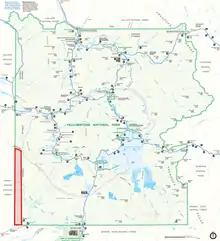Zone of Death (Yellowstone)
The Zone of Death is the name given to the 50 sq mi (129.50 km2) Idaho section of Yellowstone National Park in which, as a result of a purported loophole in the Constitution of the United States, a criminal could theoretically get away with any crime, up to and including murder.[1][2][3][4][5]

Loophole
The United States District Court for the District of Wyoming is currently the only United States district court to have jurisdiction over parts of multiple states. This is due to the fact that its jurisdiction includes all of Yellowstone National Park, which extends slightly beyond Wyoming's boundaries into Idaho and Montana. In addition, the federal government has exclusive jurisdiction over the park, so crimes committed in the park cannot be prosecuted under any of the states' laws.
Trials in the district court are normally held at the federal courthouse in Cheyenne, Wyoming. However, the Sixth Amendment to the United States Constitution decrees that juries in federal criminal cases must be made up of citizens who are from both the district and state where the crime was committed. Because of this, charges for a crime alleged to have been committed in the area of the park in Idaho would have to be tried before a jury consisting entirely of residents of that area, and the trial would also have to take place in that area.[6] As the Idaho portion of the park has no courthouses and is uninhabited, no such jury could be assembled. Thus the defendant would be unable to have a fair trial, and could not receive legal punishment for any alleged crimes.[7][6]
Discovery
The constitutional loophole in this area was discovered by Michigan State University law professor Brian C. Kalt while he was planning to write an essay about technicalities of the Sixth Amendment, which entitles criminal defendants to a fair and quick trial.[8] Kalt wondered about a hypothetical place where there were not enough eligible citizens to form a jury and theorized that there could be no trial and therefore no punishment for major crimes in that area. He later realized that there was such a place: the Idaho section of Yellowstone National Park. Horrified by his realization, Kalt shifted his focus to writing an essay about the area to persuade the government to fix the loophole. The essay, which is called "The Perfect Crime", was published in 2005 in The Georgetown Law Journal.[6] Kalt feared that criminals might read the essay and commit a crime in the Zone before the loophole was fixed.[9]
History
After Kalt discovered the loophole, he worked to have the government close it.[10] He suggested to lawmakers in Wyoming that the Zone of Death be included as part of the federal district court for the District of Idaho instead of the Wyoming district, which would fix the issue. However, the lawmakers ignored Kalt's suggestion. In 2007, author C. J. Box wrote a novel called Free Fire that featured the Zone, which Box hoped would increase governmental awareness.[11] The novel did succeed in alerting Wyoming Senator Mike Enzi to the issue. However, Enzi was unable to convince Congress to discuss it.[9]
No known felonies have been committed in the Zone of Death since Kalt's discovery. However, a poacher named Michael Belderrain illegally shot an elk in the Montana section of Yellowstone. While that section of the park does have enough residents to form a jury, it might be difficult to put together a standing and fair one due to travel or unwillingness of members of the small population there to serve. A federal judge ruled that Belderrain could be tried in the U.S. District Court for the District of Wyoming, despite the Sixth Amendment problem. Belderrain cited Kalt's paper "The Perfect Crime" to explain why he believed it was illegal to have his trial with a jury from a state other than where the crime was committed. The court dismissed this argument.[12] Belderrain took a plea deal conditioned on him not appealing the Zone of Death issue to the 10th Circuit, and the issue was left unresolved.[10]
See also
References
- Therriault, Ednor (December 2018). Myths and Legends of Yellowstone. Bowman & Littlefield. ISBN 978-1493032150. Retrieved October 20, 2018.
- Zint, Bradley (April 22, 2016). "'Population Zero,' debuting at film festival, explores the Zone of Death". Los Angeles Times. Retrieved October 20, 2018.
- "Murder in majestic Yellowstone". The Denver Post. August 2, 2007. Retrieved October 20, 2018.
- Gallagher, Katie (April 25, 2007). "MSU Law Professor Discusses Yellowstone National Park's "Zone of Death"" (Press release). Michigan State University College of Law. Archived from the original on June 27, 2020. Retrieved October 20, 2018.
- Andrews, Robin (November 26, 2017). "A Legal Loophole Might Let You Get Away With Murder In Yellowstone". Forbes. Retrieved October 20, 2018.
- Kalt, Brian C. (2005). "The Perfect Crime". The Georgetown Law Journal. 93 (2): 675. SSRN 691642. Archived from the original on January 17, 2021 – via the Michigan State University College of Law.
- Kerry, Wolfe. "Yellowstone's Zone of Death". Atlas Obscura.
- "Sixth Amendment". Legal Information Institute. Retrieved December 4, 2020.
- "Inside Yellowstone's 'Zone of Death' Crimes Can't Be Prosecuted". HowStuffWorks. October 17, 2017. Retrieved June 11, 2019.
- Kalt, Brian C. (2008). "Tabloid Constitutionalism: How a Bill Doesn't Become a Law". The Georgetown Law Journal. 96 (6): 1971, 1975–78. SSRN 1136301. Archived from the original on September 1, 2015 – via the Michigan State University School of Law.
- Box, C. J. (2007). Free Fire. New York: G.P. Putnam's Sons. ISBN 978-0399154270. LCCN 2007000539.
- Morton, Tom (March 12, 2009). "Yellowstone 'no man's land' leaves jurisdiction question". Casper Star-Tribune. Archived from the original on January 31, 2021 – via the Billings Gazette.